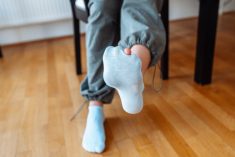No matter your age or fitness level, your ability to stabilize yourself in various positions has been shown to have a major impact on your overall wellbeing and long-term health outcomes. Your body’s ability to stabilize also directly links to your capacity for joint mobility and tension levels in your tissues.
Balance and stability are key practices I as an athletic therapist recommend to most of my clients daily. Not only does regular practice of balance help improve our physical well-being, but much research has also linked our balance capacity to our mental-emotional and cognitive function as we age.
Most physical tension in our bodies arises from the body perceiving a lack of stability, employing muscular tension to safeguard areas that are perceivably vulnerable, and holding us in position. This tension will limit our joint mobility and, combined with our largely sedentary North American lifestyles and colder winter seasons, we have a perfect recipe for an ongoing cycle of limited movement, discomfort and declining long-term health.
Read Also

Gentle treatments for pain in the neck
Heading toward year-end, people unknowingly tense up against the cold and busyness, causing neck pain that can often be treated with appropriate support and gentle mobility, athletic therapist Kathlyn Hossack says.
Luckily, practicing balance can be done at home in short and sweet doses. Here are some of my favourite ways to engage our stability systems at home.
Weight shifts to single leg stance
Start with the feet about hip width apart, soften your knees and then slowly sway your weight side to side through the hips. Progress this by eventually pausing with your weight shifted toward left or right, perhaps beginning to practice lifting the opposite foot to the toes, then perhaps hovering it while balancing on the standing side. Engage the standing-side hip muscles (as if there were a spiky wall beside you that you’d rather not bump into), press that foot into the ground and work on balancing as long as you can, or up to about 30 seconds at a time. Repeat this on the opposite side.
As you build confidence standing on one leg, you can progress toward lifting the opposite knee up higher, turning the head side-to-side or bowing the body forward while sending the lifted leg behind you.
Tandem walks
Standing with support nearby (a wall or sturdy table), place one foot directly in front of the other and get a feel for balancing between the two feet equally with soft knees. Once you are comfortable standing in this way, walk forward by stacking one foot in front of the other, as if you were walking a tight rope. It may be helpful to do this down a hallway in your home, so you have walls on either side for support. Practice while keeping your eyes looking forward and repeat for a few lengths of your hallway, or about 10-20 steps at a time. If walking forward feels good, you can practice walking backward in the same way.
If pain prevents you from practicing movement, or your stability impacts your ability to move well and safely in your daily life, it’s important to seek the guidance and support of your health care team. Movement based health professionals such as athletic therapists, physiotherapists or fitness professionals can be excellent resources for guiding your specific needs. Regardless of your age, practicing balance and stability will benefit your overall health, prevent injuries and keep you moving through life for the long term.















